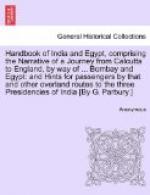There Fortune smiled upon her and wealth poured into her lap. Two years later by dint of careful inquiry she discovered that the stern-faced woman who had abandoned her in the Lahore market was her uncle’s wife, now widowed and in poverty; and to her she of her bounty gave a pension. For Imtiazan, though she never forgot, could always forgive and had never lost the sense of her duty to relations. She also provided for the old man who had helped her when a child to build the dust-castles beneath the trees of her old home; and then, while still young and with enough money left to keep herself in comparative affluence, she turned her back for ever upon the profession which she loathed and devoted the rest of her life to the careful rearing of an orphan girl, whom the desire for a child of her own and the memories of her own youth urged her to adopt. When she died, the child who had grown up and under her guidance had married a respectable merchant, mourned for her as one mourns for those who have lovingly shielded our infancy and youth; and many of the neighbours were sincerely grieved that Imtiazan had departed for ever.
Such is the life-history of Imtiazan, one of the most famous dancing-girls Bombay has ever known—a history that lacks not pathos. After her final renunciation of the profession of singing and dancing she might have remarried and in fact received more than one offer from men who were attracted by her kindliness of heart and by her beauty. But she declined them all with the words “Marriage is not my kismet,” which is but the Indian equivalent of “My faith hath departed and my heart is broken.” Surely the earth lies very lightly upon Imtiazan.
VI.
THE BOMBAY MOHURRUM.
STRAY SCENES.
The luxury of grief seems common to mankind all the world over, and the mourning of the Mohurrum finds its counterpart in the old lamentation for the slain Adonis, the emotional tale of Sohrab’s death at the hand of his sire Rustom, and the long-drawn sorrow of the Christian Passion. The Persian inclination towards the emotional side of human nature was not slow to discover amid the early martyrs of the Faith one figure whose pathetic end was powerful to awaken every chord of human pity. The picture of the women and children of high lineage deceived, deserted and tortured with thirst, of the child’s arms lopped at the wrist even at the moment they were stretched forth for the blessing of the Imam, of the noblest chief of Islam betrayed and choosing death to dishonour, of his last lonely onset, his death and mutilation at the hand of a former friend and fellow-champion of the faith,—this picture indeed appealed and still appeals, as no other can, to the hidden depths of the Persian heart. The Sunni may object to the choice of Hasan and Husain as the martyrs most worthy of lamentation, putting forward in their stead Omar, companion of the Prophet himself, who lingered




